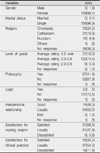Abstract
Purpose
This study was done to identify the relationship between critical thinking disposition and problem solving ability in nursing students, thereby providing basic data for nursing education.
Method
A convenience sample was drawn from 161 nursing students. Data were collected from June 2008 to October 2008. Instruments used in the study were the California Critical Thinking Disposition Inventory (CCTDI) developed by Facione & Facione (1992) and the Problem Solving Inventory (PSI) developed by Heppner & Petersen (1982). The collected data were analyzed using t-test, ANOVA, Scheffe' test, Pearson correlation coefficients and multiple regression with SPSS 12.0.
Results
The total mean score for CCTDI was 278.41 and PSI was 119.23. For general characteristics, there were statistically significant differences in CCTDI according to satisfaction with nursing majors (F=6.29, p=.00) and PSI according to academic achievement (F=3.45, p=.02) and marital status (t=2.43, p=.02). A statistically significant negative correlation was found between CCTDI and PSI. Critical thinking self-confidence, Analyticity and Inquisitiveness were significant predictors of PSI.
Figures and Tables
References
1. Brown K. Education, culture and critical thinking. 1998. Aldershot: Ashgate.
2. Chang AM, Gaskill D. Nurse's perceptions of their problem-solving ability. J Adv Nurs. 1991. 16(7):813–819.

3. Cho HS. A study on the critical thinking disposition and self-directed learning, academic achievement of nursing students. J Korean Soc Health Inf Health Stat. 2007. 32(2):57–72.
4. Choi E, Kim J. The relationship of core competencies (problem solving ability, communication ability, self-directed learning ability) to critical thinking. J Korean Acad Fundam Nurs. 2007. 14(4):412–419.
5. Choi H. The effects of PBL (Problem-Based Learning) on the metacognition, critical thinking, and problem solving process of nursing students. J Korean Acad Nurs. 2004. 34(5):712–721.

6. Choi YY. The effects of the two different kinds of problem structure and the level of problem-solving competency on problem solving in an astronomy simulation. 2004. Seoul: Ewha Womans University;Department of Educational Technology. Unpublished master's thesis.
7. Chun SG. Study on the effectiveness of social skills training program for rehabilitation of the schizophrenic patients. 1994. Seoul: Soongsil University;Unpublished master's thesis.
8. Facione PA, Facione NC. The california critical thinking disposition inventory (CCTDI) test administration manual. 1992. Millbrae, CA: California Academic Press.
9. Facione N, Facione P. Critical thinking assessment in nursing education programs: an aggregate data analysis. 1997. Millbrae, CA: California Academic Press.
10. Finkelman AW. Problem-solving, decision-making, and critical thinking: how do they mix and why bother? Home Care Provid. 2001. 6(6):194–199.

11. Han SJ. A study on relationship between empowerment and satisfaction of clinical practice in nursing student. J Korean Acad Soc Nurs Educ. 2000. 6(1):132–146.
12. Heppner PP. The problem solving inventory (PSI): manual. 1988. Palo Alto, CA: Consulting Psychologists Press.
13. Heppner PP, Petersen CH. The development and implications of a personal problem-solving inventory. J Couns Psychol. 1982. 29(1):66–75.

14. Heider F. The psychology of interpersonal relations. 1958. New York: John Wiley & Sons.
15. Howenstein MA, Bilodeau K, Brogna MJ, Good G. Factors associated with critical thinking among nurses. J Contin Educ Nurs. 1996. 27(3):100–103.

16. Hurst K, Dean A, Trickey S. The recognition and non-recognition of problem-solving stages in nursing practice. J Adv Nurs. 1991. 16(12):1444–1455.

17. Ip WY, Lee DT, Lee IF, Chau JP, Wootton YS, Chang AM. Disposition towards critical thinking: a study of chinese undergraduate nursing students. J Adv Nurs. 2000. 32(1):84–90.

18. Jang KS, Kim NY, Ryu SA, Kim YM, Chung KH. Effects of collaborative learning on problem-solving processes according to the level of metacognition in clinical practice of nursing management. J Korean Acad Nurs Adm. 2007. 13(2):191–198.
19. Seymour B, Kinn S, Sutherland N. Valuing both critical and creative thinking in clinical practice: narrowing the research-practice gap? J Adv Nurs. 2003. 42(3):288–296.

20. Shin K, Jung DY, Shin S, Kim MS. Critical thinking disposition and skills of senior nursing students in associate baccalaureate, and RN to BSN programs. J Nurs Educ. 2006. 45(6):233–237.

21. Shin KR. A study of critical thinking ability of associate and baccalaureate degree nursing students. J Nurs Acad Soc. 1996. 26(1):43–52.

22. Shin KR, Hwang JW, Shin SJ. Concept analysis on the clinical critical thinking ability in nursing. J Korean Acad Adult Nurs. 2008. 20(5):707–718.
23. Sung MH, Eum OB. Relationships between critical thinking disposition, professional nursing competence and job satisfaction in clinical nurses. J Korean Acad Nurs Adm. 2009. 15(1):26–36.
24. Terzioglu F. The perceived problem-solving ability of nurse managers. J Nurs Manag. 2006. 14(5):340–347.

25. Uys LR, Van Rhyn LL, Gwele NS, Mclnerney P, Tanga T. Problem-solving competency of nursing graduates. J Adv Nurs. 2004. 48(5):500–509.
26. Videbeck SL. Critical thinking: Prevailing practice in baccalaureate schools of nursing. J Nurs Educ. 1997. 36(1):5–10.

27. Yang SA, Jung DY. A study on the critical thinking disposition about student nurse. J Korean Acad Adult Nurs. 2004. 16(1):156–165.
28. Yang S, Lee KJ, Yu SJ. Self-evaluative awareness of problem solving ability in psychiatric nurse practitioners. J Korea Community Health Nurs Acad Soc. 2002. 16(2):378–387.
29. Yoo JS. Development of a problem solving training model and its effectiveness -the comparison of effectiveness between cognitive-behavioral an cognitive-affective-behavioral problem solving training-. 1993. Chonnam: Chonnam University;Unpublished master's thesis.
30. Yoon J. A study on the critical thinking disposition of nursing students: focusing on a school applying integrated nursing curriculum. J Korean Acad Nurs Adm. 2008. 14(2):159–166.




 PDF
PDF ePub
ePub Citation
Citation Print
Print







 XML Download
XML Download